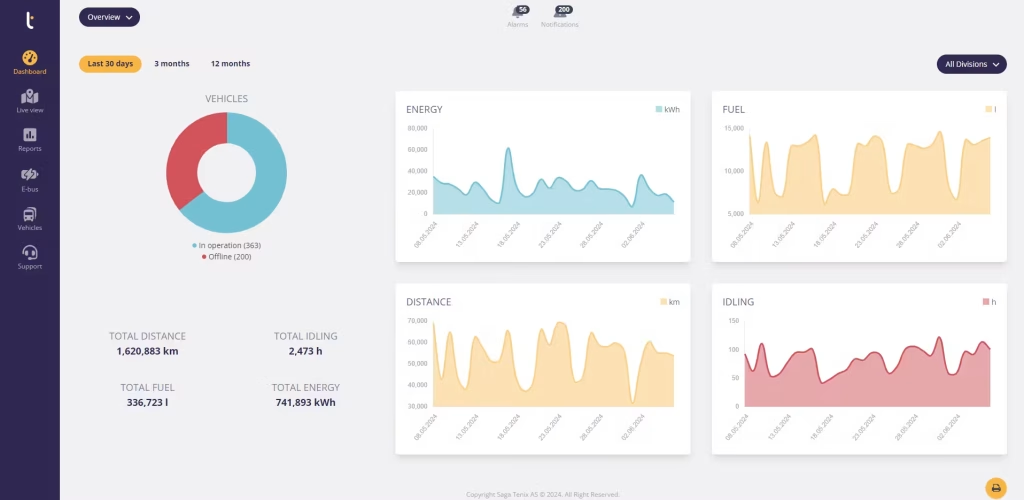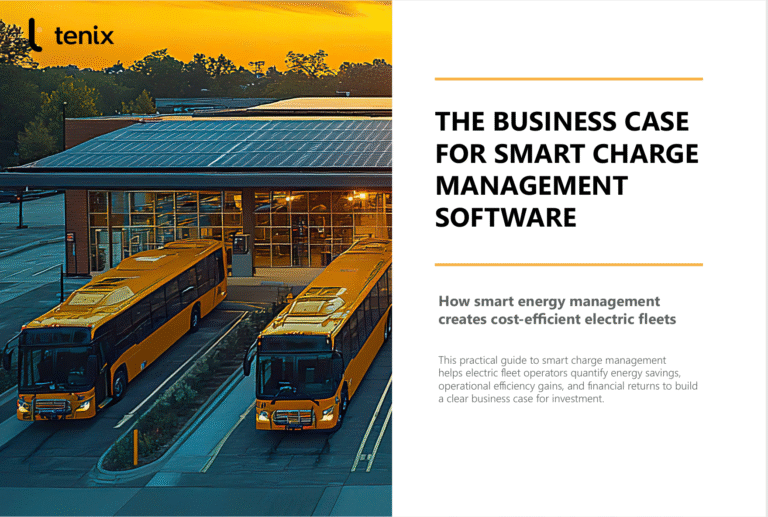Efficient driving is one of the simplest ways to cut emissions and reduce costs, yet it is often overlooked in the shift toward electrification and automation. Every trip, every acceleration, and every stop affects fuel use, wear on components, and passenger comfort. Tenix Eco-Drive gives operators the data and tools to measure these behaviours accurately and turn them into tangible improvements across the fleet.
Why Driving Behaviour Matters
For both bus and truck fleets, how a vehicle is driven can have a larger impact on cost than what it runs on. Hard braking, rapid acceleration, long idling times, and poor anticipation of traffic all lead to higher fuel consumption, unnecessary maintenance, and reduced passenger comfort.
Research by the Transport Ministry of Austria shows that eco-driving techniques can lower fuel use by 10 to 15 percent in conventional vehicles. In electric fleets, smoother acceleration and regenerative braking can extend range by a similar margin. For operators managing dozens or hundreds of vehicles, those percentages translate into major savings.
From Assumption to Measurement
Traditionally, assessing driving style relied on assumptions or anecdotal feedback. Tenix replaces that with measurable data. Eco-Drive collects detailed driving metrics directly from vehicle systems, including acceleration profiles, braking intensity, idling duration, and speed consistency.
These data points are processed into a clear driver performance score that fleet managers can view at any time. Instead of relying on intuition, operators can see exactly where inefficiencies occur and how they affect energy consumption, maintenance, and even passenger experience.
For example, frequent harsh braking may indicate a need for better route timing or driver anticipation training. Extended idling might highlight scheduling issues or under-used vehicles. By connecting these insights with operational data, Tenix helps managers turn small behavioural changes into measurable cost reductions.
Key Benefits of Eco-Drive
1. Reduced Operating Costs
Efficient driving lowers both fuel and maintenance expenses. Tenix customers typically see double-digit reductions in energy use after adopting Eco-Drive insights in daily operations. For diesel or hybrid fleets, this means direct fuel savings. For electric fleets, it means extended range and fewer charging sessions.
2. Better Driver Feedback and Training
Eco-Drive provides clear and objective feedback, allowing managers to identify top performers and areas for improvement. Drivers can see their own data through simple dashboards, promoting healthy competition and a shared focus on efficiency. Targeted training sessions are then based on evidence, not guesswork.
3. Lower Emissions
Every litre of fuel or kilowatt-hour saved reduces carbon emissions. A fleet improving its efficiency by 10 percent can cut annual CO₂ emissions by tens of tonnes, contributing directly to ESG and sustainability reporting requirements.
4. Improved Passenger Comfort and Safety
For public transport, smoother acceleration and braking make journeys more comfortable and safer for passengers. Reduced harsh manoeuvres also decrease wear on brakes and tyres, extending vehicle lifespan.
How Eco-Drive Works in Practice
Data from each vehicle is transmitted to the Tenix Fleet platform, where Eco-Drive processes it in real time. Fleet managers can filter results by driver, vehicle type, or route to identify trends.
For example:
- A city bus operator might discover that certain routes cause higher energy use due to steep gradients or heavy traffic. Adjusting schedules or retraining drivers on those routes can reduce consumption.
- A logistics company might find that specific drivers consistently exceed optimal acceleration thresholds. Focused feedback can improve performance and lower costs within weeks.
This feedback loop is what makes Eco-Drive powerful. It transforms routine driving data into actionable insights that improve both operational efficiency and sustainability performance.
Integrating Eco-Drive with the Wider Fleet
Eco-Drive does not operate in isolation. It integrates directly with Tenix Fleet and Tenix Charge, creating a single operational picture. Driving data can be linked with energy consumption, charging behaviour, and maintenance records, helping managers understand the full impact of driving habits on cost and performance.
For instance, a depot may notice that smoother driving correlates with fewer charging events and extended battery health. Over time, these insights help operators make smarter decisions about scheduling, route planning, and energy use.
Driving Change for a More Sustainable Fleet
Efficient driving is not only about saving energy; it is about building a culture of responsibility and performance. Tenix Eco-Drive helps fleets achieve this by combining precise data with clear, actionable reporting.
Operators who integrate Eco-Drive into their daily routines typically see lower fuel and maintenance costs, improved driver engagement, and measurable reductions in emissions. More importantly, they gain visibility into one of the last major variables in fleet performance: the human factor.
With Eco-Drive, Tenix brings transparency and improvement to how vehicles are driven, making every journey safer, smoother, and more sustainable., businesses can achieve cost savings, reduce emissions, contribute to a more sustainable future and even improve passenger experiences for those in the public transport.





